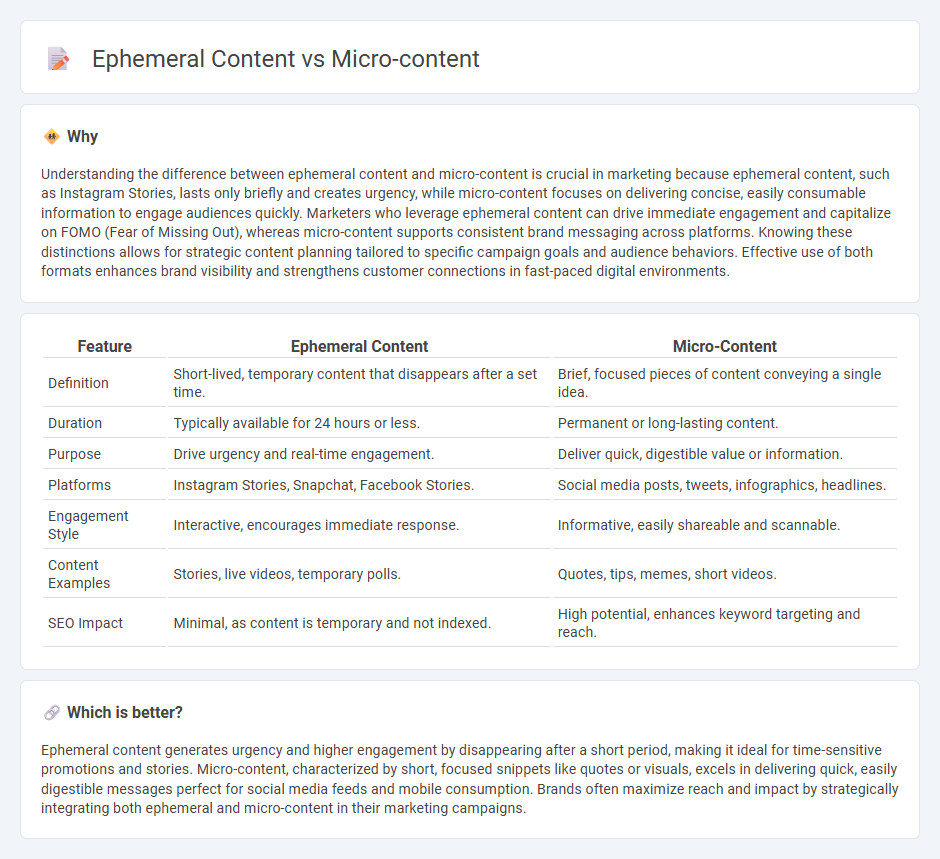
Ephemeral content includes temporary posts like Instagram Stories and Snapchat Snaps designed to engage audiences with timely, fleeting messages that disappear after a short duration. Micro-content consists of brief, easily digestible pieces such as tweets, memes, or short videos that deliver quick value and maintain audience attention. Explore the unique advantages of ephemeral and micro-content strategies to boost your marketing impact.
Why it is important
Understanding the difference between ephemeral content and micro-content is crucial in marketing because ephemeral content, such as Instagram Stories, lasts only briefly and creates urgency, while micro-content focuses on delivering concise, easily consumable information to engage audiences quickly. Marketers who leverage ephemeral content can drive immediate engagement and capitalize on FOMO (Fear of Missing Out), whereas micro-content supports consistent brand messaging across platforms. Knowing these distinctions allows for strategic content planning tailored to specific campaign goals and audience behaviors. Effective use of both formats enhances brand visibility and strengthens customer connections in fast-paced digital environments.
Comparison Table
| Feature | Ephemeral Content | Micro-Content |
|---|---|---|
| Definition | Short-lived, temporary content that disappears after a set time. | Brief, focused pieces of content conveying a single idea. |
| Duration | Typically available for 24 hours or less. | Permanent or long-lasting content. |
| Purpose | Drive urgency and real-time engagement. | Deliver quick, digestible value or information. |
| Platforms | Instagram Stories, Snapchat, Facebook Stories. | Social media posts, tweets, infographics, headlines. |
| Engagement Style | Interactive, encourages immediate response. | Informative, easily shareable and scannable. |
| Content Examples | Stories, live videos, temporary polls. | Quotes, tips, memes, short videos. |
| SEO Impact | Minimal, as content is temporary and not indexed. | High potential, enhances keyword targeting and reach. |
Which is better?
Ephemeral content generates urgency and higher engagement by disappearing after a short period, making it ideal for time-sensitive promotions and stories. Micro-content, characterized by short, focused snippets like quotes or visuals, excels in delivering quick, easily digestible messages perfect for social media feeds and mobile consumption. Brands often maximize reach and impact by strategically integrating both ephemeral and micro-content in their marketing campaigns.
Connection
Ephemeral content and micro-content both target fast consumption and high engagement by delivering brief, impactful messages tailored for social media platforms. Ephemeral content, such as Instagram Stories or Snapchat Snaps, expires quickly, creating urgency, while micro-content includes short videos, memes, or infographics designed for immediate sharing and comprehension. Their synergy enhances brand visibility and audience interaction through concise, timely, and easily digestible marketing materials.
Key Terms
Attention Span
Micro-content and ephemeral content both target brief attention spans but differ in their delivery and longevity; micro-content consists of concise, reusable snippets like quotes or tips, while ephemeral content includes temporary posts, such as Instagram Stories, that disappear after 24 hours. By leveraging the fleeting nature of ephemeral content, brands create urgency and immediacy, enhancing user engagement within seconds. Explore the dynamics of how attention span shapes content strategies to optimize audience interaction.
Lifespan
Micro-content typically has a longer lifespan, remaining relevant and accessible across platforms for extended periods due to its concise, reusable format. Ephemeral content, conversely, is designed for brief visibility, often disappearing within 24 hours after posting, creating urgency but limited long-term engagement. Explore deeper insights on how content lifespan impacts digital marketing strategies and audience retention.
Platform Optimization
Micro-content refers to small, self-contained pieces of information designed for quick consumption, while ephemeral content is temporary and disappears after a set time, often used on platforms like Instagram Stories or Snapchat. Platform optimization for micro-content involves crafting concise, engaging snippets tailored to user behavior on feeds, whereas ephemeral content optimization focuses on immediacy and exclusivity to boost real-time interaction. Explore platform-specific strategies to maximize engagement and reach with both micro-content and ephemeral content.
Source and External Links
What Is Micro Content? (Examples & Tips) - Micro content is any small, easily digestible piece of content--such as tweets, infographics, memes, or short videos--designed to quickly capture attention and convey a message in seconds.
What is Micro-Content? [+ Examples of the Best Types] - Micro-content refers to short, bite-sized content (like social media updates, Google snippets, and lists) that audiences can consume rapidly, often on platforms with strict character limits.
Microcontent - Originally defined by Jakob Nielsen, microcontent consists of concise text elements--such as headlines, page titles, and email subject lines--that provide a clear summary of larger content and remain meaningful even when viewed out of context.
 dowidth.com
dowidth.com